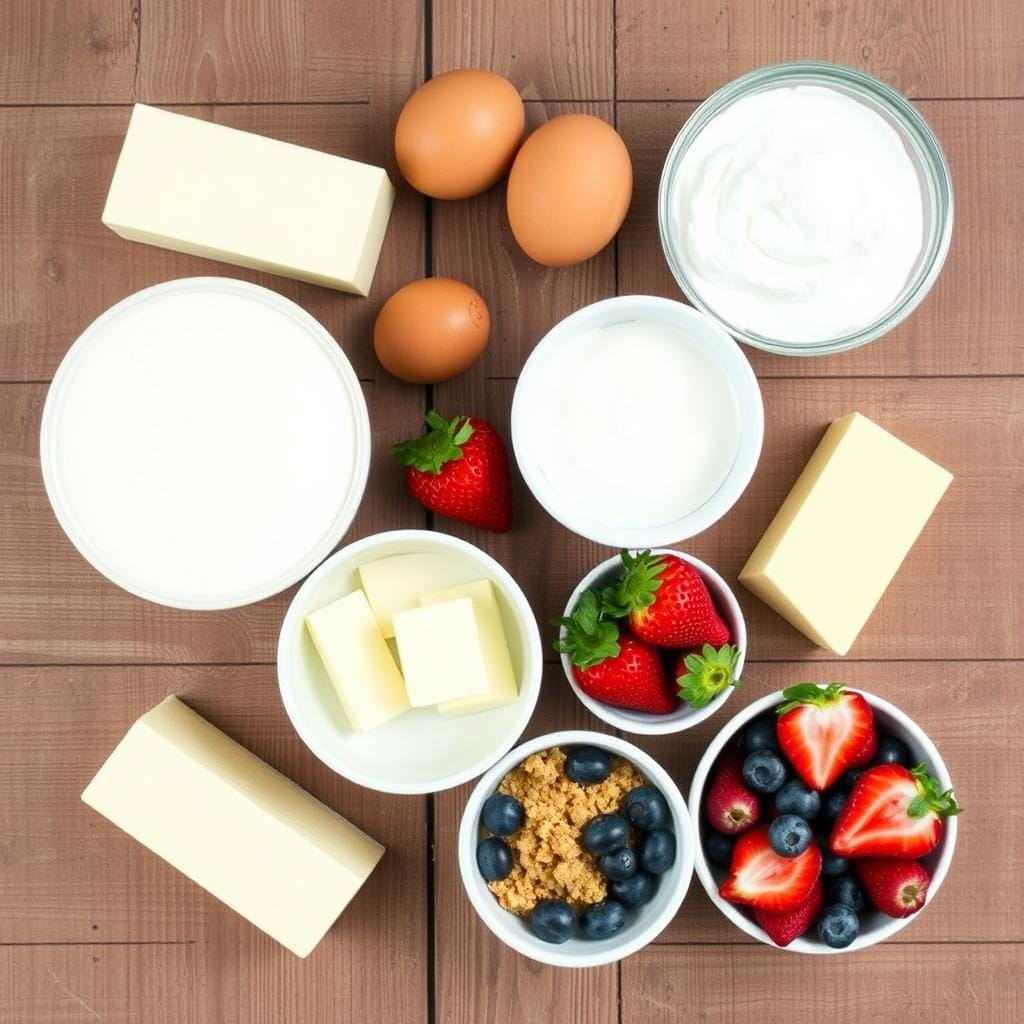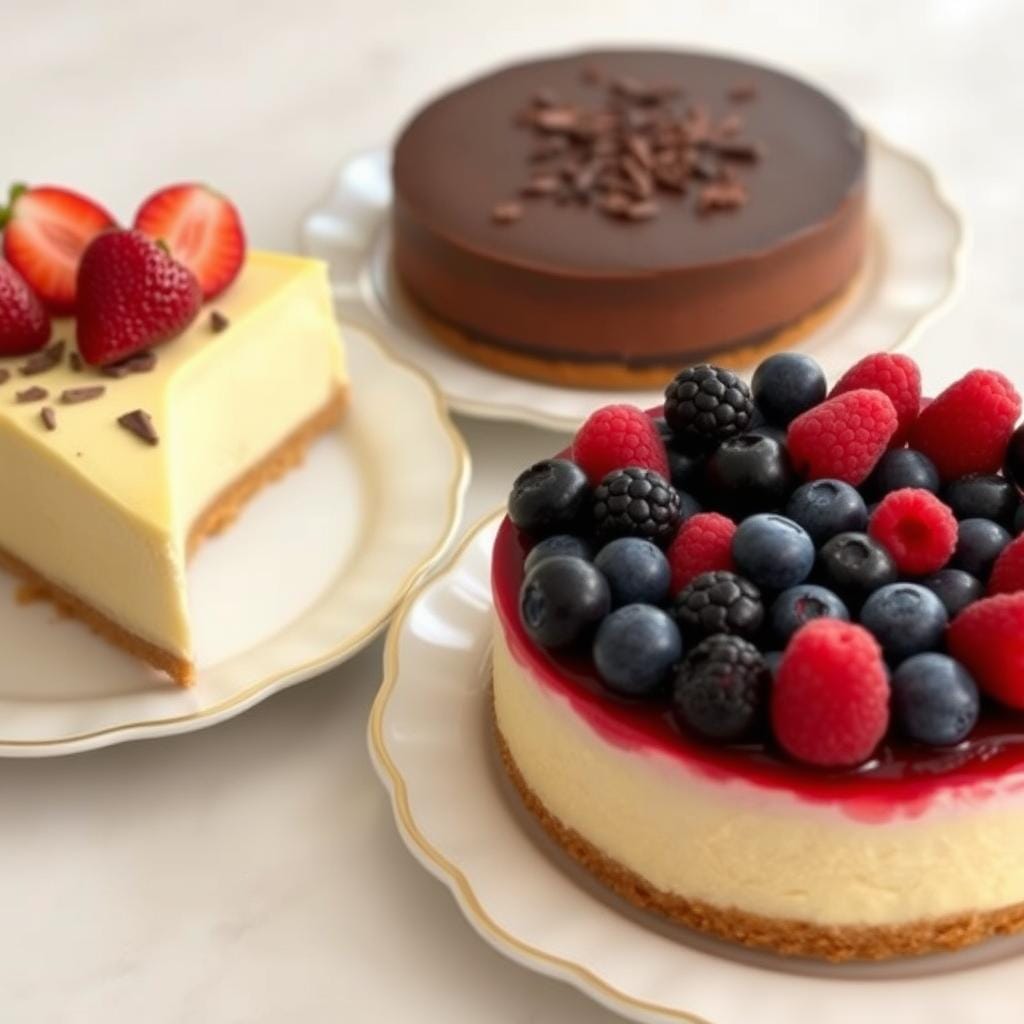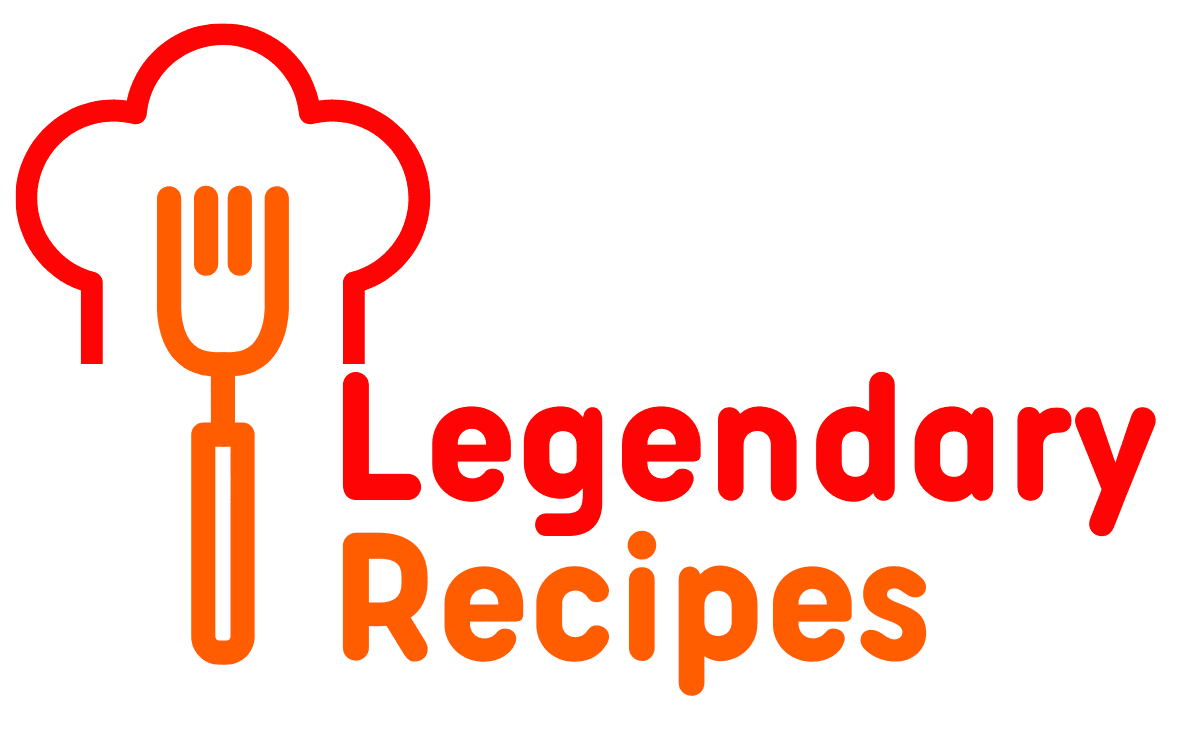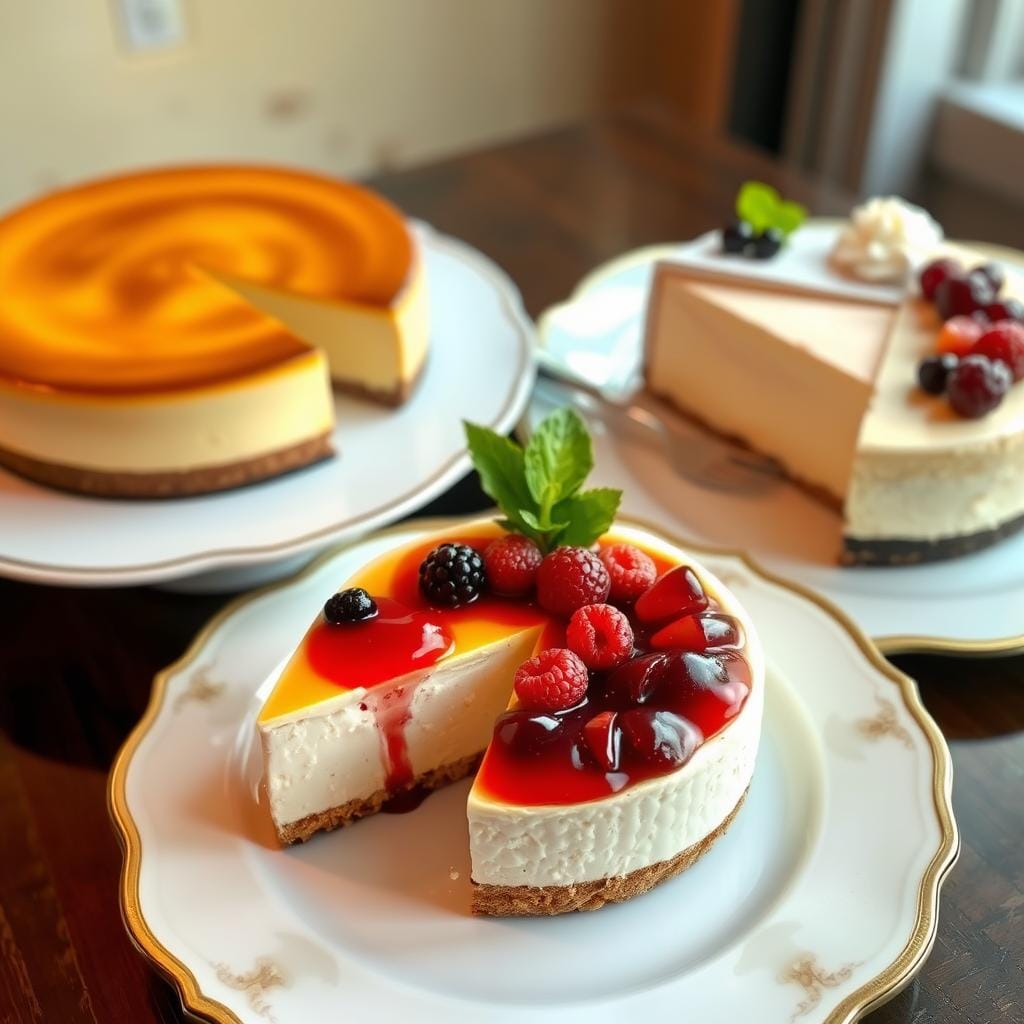Key Takeaways
- Explore the three primary categories of cheesecake: baked, no-bake, and Japanese souffle
- Uncover the essential ingredients and equipment needed to craft the perfect cheesecake
- Master the techniques for achieving the ideal texture and flavor in your cheesecakes
- Discover a world of cheesecake variations beyond the classic New York-style
- Learn how to troubleshoot common cheesecake problems and maintain optimal storage
Understanding the Art of Cheesecake Making
Making the perfect classic cheesecake or any tasty cheesecake recipes needs a good grasp of key ingredients and techniques. Knowing the essential parts, the right tools, and the importance of temperature can boost your baking skills. It will also wow your family and friends.
Essential Ingredients for Perfect Cheesecake
Every great cheesecake starts with a mix of key ingredients. The base of a classic cheesecake usually has:
- Cream cheese, for a rich, creamy texture
- Eggs, which provide structure and a smooth consistency
- Sugar, to balance the tang of the cream cheese
- Vanilla extract, for a fragrant, aromatic touch
Basic Equipment and Tools
To make the perfect cheesecake, you need the right tools and equipment. Some must-haves include:
- Springform pan, for easy removal and a smooth, even bake
- Stand mixer or hand mixer, to thoroughly blend the ingredients
- Parchment paper, to line the pan and prevent sticking
- Spatula, to ensure all the batter is incorporated
Temperature Considerations
Temperature is key to a successful cheesecake. Proper temperature control during baking and cooling is vital. It helps avoid cracks, gets the right texture, and ensures a great taste. Paying attention to temperature is crucial for your classic cheesecake or cheesecake recipes.

“Baking is like washing dishes, you just have to get in there and do it. It’s fun! I find it relaxing.” – Carla Hall
What Are the Three Types of Cheesecake?
Cheesecake is a top pick for dessert lovers. But did you know there are three main types? Each has its own special taste. Let’s dive into the differences and find your new favorite.
Classic Baked Cheesecake
The traditional baked cheesecake is a favorite. It’s made with cream cheese, eggs, sugar, and more. Baked in a springform pan, it’s smooth and creamy.
No-Bake Cheesecake
For a quick and light option, try the no-bake cheesecake. It uses cream cheese, sweetened condensed milk, and gelatin. This makes it silky and perfect for summer.
Japanese-Style Souffle Cheesecake
The souffle cheesecake comes from Japan. It’s light and airy, thanks to egg whites. This makes it a unique and impressive dessert.
Looking for a rich baked cheesecake, a cool no-bake treat, or a light souffle? There’s a cheesecake for everyone. Try these three types and find your favorite!

Classic Baked Cheesecake: The Traditional Method
The classic baked cheesecake is a timeless favorite. It’s known for its rich, creamy, and indulgent taste. This method has won hearts for generations.
Water Bath Technique
The water bath technique is key for a perfect cheesecake. It involves placing the cheesecake pan in a larger pan with hot water. This creates a gentle heat that prevents cracking and gives a smooth texture.
Baking Time and Temperature
Getting the baking time and temperature right is crucial. Bake at 325°F (165°C) for 60-90 minutes. This slow baking makes the center firm and the edges creamy.
Cooling and Setting Process
After baking, the cooling and setting process is magical. Leave the cheesecake in the oven with the door ajar for an hour. Then, move it to the fridge for at least 4 hours, or overnight, before serving.
Mastering the water bath, baking, and cooling techniques will help you make a classic baked cheesecake. It will rival the best New York-style treats.
No-Bake Cheesecake: The Quick Alternative
Craving cheesecake but short on time? Check out no-bake cheesecake. It’s a quick and easy way to enjoy cheesecake without baking.
No-bake cheesecakes have a simple crust. It’s made from crushed graham crackers, cookies, or nuts. The filling is smooth and creamy, thanks to gelatin or cream cheese.
Making no-bake cheesecake is easy. You just mix the filling, pour it into a crust, and chill it. It’s perfect for beginners or when you’re in a hurry.
No-bake cheesecakes are also super customizable. You can add fresh fruit or chocolate ganache. Get creative and make your own unique cheesecake.
| Ingredient | Quantity |
|---|---|
| Cream Cheese | 24 oz (680g) |
| Sweetened Condensed Milk | 14 oz (396g) |
| Lemon Juice | 2 tbsp |
| Graham Cracker Crumbs | 1 1/2 cups (180g) |
| Unsalted Butter, melted | 5 tbsp (70g) |
“There’s nothing quite like the creamy, indulgent texture of a no-bake cheesecake. It’s the perfect treat for when you want something sweet and satisfying without the fuss of baking.”
Japanese-Style Souffle Cheesecake
Explore the world of Japanese-style souffle cheesecake. It’s a unique twist on the classic cheesecake recipes. This cheesecake is known for its light, airy texture, thanks to whipping egg whites to perfection.
Special Ingredients Needed
To get that souffle texture, you’ll need some special ingredients. You’ll need cream cheese, cake flour, eggs, and a bit of sugar. The trick is to fold the egg whites into the batter carefully. This ensures a light and airy final product.
Achieving the Perfect Rise
- Whip the egg whites until they’re stiff and glossy for the best rise.
- Fold the whipped whites into the cream cheese batter gently. This helps keep the mix light.
- Bake the cheesecake in a water bath. This helps it cook evenly and prevents it from cracking.
Serving Recommendations
After baking your Japanese-style souffle cheesecake perfectly, it’s time to enjoy it. Serve it chilled. Add powdered sugar or a fresh fruit compote for extra flavor. Its light texture makes it perfect for any time of day.
“The key to a perfect Japanese-style souffle cheesecake is in the meticulous technique. With the right approach, you can create a dessert that is both light and indulgent.”
Popular Cheesecake Variations Around the World
Cheesecake lovers will find joy in the many unique types from around the world. From Italy’s creamy ricotta cheesecake to vegan cheesecakes, the variety is vast and exciting.
The Basque cheesecake from Spain’s Basque region is a favorite. It has a caramelized outside and a creamy inside. Japan’s souffle-style cheesecake is famous for its light, airy texture.
“Cheesecake is a reflection of the unique culinary traditions and flavors of the regions that have embraced it.”
There are countless cheesecake types to try. From the dense New York-style to the light Chicago-style, each has its own taste. You can even find savory ricotta cheesecake and rich vegan cheesecake.
Exploring cheesecake from different cultures is a treat. Whether you like traditional or modern cheesecakes, there’s something for everyone.
Common Cheesecake Problems and Solutions
Baking the perfect cheesecake recipes is an art. With the right techniques, you can avoid common issues. This way, you’ll get smooth, crack-free results every time. Whether you’re making a classic baked cheesecake or trying new styles, knowing how to solve problems is crucial.
Preventing Cracks and Splits
Cracks or splits in cheesecakes are frustrating. They can happen due to quick temperature changes, over-mixing, or not cooling enough. To avoid this, use a water bath while baking. Also, don’t over-whip the batter, and let the cheesecake cool slowly before chilling.
Texture Troubleshooting
If your cheesecake feels too dense, dry, or grainy, it might be due to wrong ingredient ratios or mixing. Make sure you’re using the right amounts of cream cheese, eggs, and other ingredients. Also, mix them gently to avoid overworking the batter.
Storage Tips
- Wrap the cheesecake tightly in plastic wrap or foil to prevent it from drying out in the fridge.
- For optimal texture, allow the cheesecake to come to room temperature before serving.
- Freeze leftover slices for up to 2 months, thawing in the refrigerator before enjoying.
Mastering these techniques will help you make cheesecake recipes that look great and taste amazing. With practice and attention to detail, you can bake perfect cheesecakes every time.
Conclusion
In this guide, you’ve learned about three types of cheesecake: classic baked, no-bake, and Japanese-style souffle. Each type has its own texture, flavor, and way of making. They suit different tastes and events.
If you love cheesecake or are new to it, try something different. You might enjoy the light souffle-style or the simple no-bake cheesecake. Exploring these options can make your dessert game stronger.
Learning to make cheesecake is rewarding. It’s not just about the dessert but also about the joy of cooking. So, start making cheesecakes and enjoy the journey of discovery.


